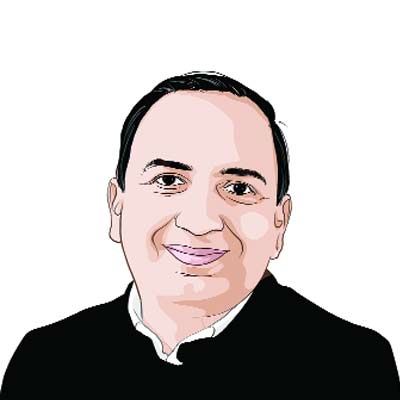Opinion A separate entrance test for DU won’t solve anything
🔴 Pratap Bhanu Mehta writes: The pressure on Delhi University will be eased if our regional universities are vastly improved
 With students away from Delhi University for almost two years, several businesses in North Campus which had developed around their needs – paying guest accommodations, tiffin services to photocopiers – took a severe hit. (Express Photo/File)
With students away from Delhi University for almost two years, several businesses in North Campus which had developed around their needs – paying guest accommodations, tiffin services to photocopiers – took a severe hit. (Express Photo/File) The political distemper of our times has crowded out of the space for discussion issues of long term consequence. In higher education, decisions are being taken that will affect the lives of millions of students. One such decision is Delhi University’s decision to conduct admissions using either a Central Universities Entrance Exam or its own entrance exam. The decision has been announced without detailing the nature, character and purpose of this exam. Universities need to reassess their methods from time to time. But this decision seems to be only half thought through. Changing the admissions criteria a few months before next year’s admissions smacks of callous disregard for students, especially in an era of Covid disruptions. A momentous decision like this one needs to be announced at least a couple of years in advance.
But there is also no adequate explanation for exactly what problem this test is meant to solve. The immediate context of the decision was the fact that a disproportionately large number of students from states like Kerala were getting admission. Somehow, this exam is meant to create a level playing field. The registrar’s public explanation went: “In the past few years, we have seen students getting exorbitant marks, which in turn was leading to very high cut-offs. The entrance exam from this year will bring some relief to students. The pressure of high cut-offs will not be there. They can focus on specific subjects for preparation.”
These rationales are misleading. Cut-offs have become incredibly high. But to think a separate entrance exam is a solution to that problem and brings relief to the students defies logic. It adds the burden of yet another exam on the students. You now have a situation where students can excel at school and boards, but will have virtually no place to go without the burden of more exams. Although school will remain a qualifying criterion, its importance will be diminished. The pressure on Delhi University is the pressure of numbers; the demand is high and the number of top colleges is very small. The pressure to get into the top ranks or percentiles of the exams will still remain. This is a country where in a range of exams marks are calculated to the seventh decimal place to decide who will get selected. Every single place where we have an exam, from IIT to CLAT, is pressure ridden because of the law of numbers. So the idea that this exam will be a relief is strange.
It is still not clear how this exam will be designed and what its purpose is. Many of our exams like CLAT and IIT are for institutions that have two features: They are for a specific course of study, and typically the purpose of the exam is to sort out the top point one per cent or even less from the rest. Delhi University is a broader university both in breadth and numbers. It also plans to move to a more choice based, interdisciplinary liberal arts model. It is not clear what the university meant by “they can focus on specific subjects for preparation.” This claim is in tension with the pedagogical objectives of Delhi University. If these are going to be subject tests, it belies the stated broadening of DU’s curriculum. On the other hand, if it is going to be a general aptitude test, then one has to clearly be aware of the pitfalls. Wherever general aptitude tests are used for admission, they are only one amongst several criteria that go into determining admissions. It is not clear that Delhi University is in a position to introduce those kinds of holistic assessments. So the question, what is Delhi University testing for, remains an open one. The current system may not be ideal, but it is not clear that an additional exam with no demonstrated pedagogical utility will help.
Exams in India have a dual function. On the one hand, they do provide avenues for social advancement to those without social or economic capital: There is an assurance of some “objective” criteria of assessment. On the other hand, we also know from global evidence that success at exams is also a function of the ability to invest in coaching etc; they can reproduce other forms of capital rather than acting as a counter to it. For an institution like Delhi University, it is highly likely that if another exam is introduced, the second effect will dominate over the first. This is the biggest gift the coaching industry will get.
 To ease the pressure on Delhi University you need to create more high quality institutions. But there is also a larger elephant in the room we do not discuss. How much of the pressure on higher education is not a creation of the education system, but of the larger job market? The more inequality of opportunity there is in the job market, the higher the social and economic stakes in top institutions. It is the structural bottlenecks of the larger economic environment that are driving the pathologies of education, rather than education being an antidote to them.
To ease the pressure on Delhi University you need to create more high quality institutions. But there is also a larger elephant in the room we do not discuss. How much of the pressure on higher education is not a creation of the education system, but of the larger job market? The more inequality of opportunity there is in the job market, the higher the social and economic stakes in top institutions. It is the structural bottlenecks of the larger economic environment that are driving the pathologies of education, rather than education being an antidote to them.
Callousness and casualness about higher education runs across governments of different political parties. The pressure on Delhi University will be eased if our regional universities are vastly improved. But we are determined to go in the opposite direction. The Odisha Universities Amendment Act (2020) centralises the appointments of all university teachers in the hands of a state-wide commission that will conduct exams for such appointments, which will also be like transferable jobs. It boggles the mind: What kind of centralising, bureaucratic imagination imagines universities and teaching this way? State governments are reeling under the powers exercised by governors in appointing vice-chancellors. This is a long-standing structural issue, exacerbated by a politicisation of the governor’s office. But the solutions being proposed are worse than the disease. For instance, Maharashtra has proposed that the Higher and Technical Education Minister be made pro-chancellor of all universities, and wrest more control over appointments. States demand autonomy all the time. But there is not a single state government that has a credible approach to public universities.
In a world where all institutions are under assault, this discussion may be moot. But once in a while, can we at least pretend to have a good faith discussion on the direction of our top public universities, whether it is Delhi or Utkal or Mumbai?
This column first appeared in the print edition on January 8, 2022 under the title ‘An ‘F’ for this exam’. The writer is contributing editor at The Indian Express





